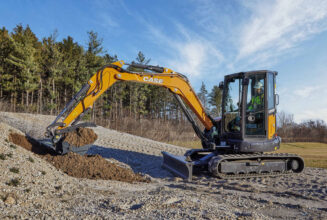Designing for the “Dry Spells”
By Elinor Markle
2007 brought a crushing drought to the southeastern United States. In my own back yard, I watched in disbelief as a native maple tree that had stood in good health for 50 years shed its leaves in July. Standing ankle deep in its crisp, khaki colored leaves, I was frightened to realize just how much we are truly at the mercy of Mother Nature. The lesson was not lost on others, either; property owners here are freshly aware that a installing a drought-tolerant landscape is not a kooky notion for greenies, but a reasonable and prudent approach to managing their own property.
Designing a drought-tolerant landscape is not a matter of simply specifying cactus and sedums. It requires multiple changes in the way we think about the landscape, and how we specify and install planting beds and lawns. It will make an overall difference that is measurable in terms of irrigation requirements, time spent in routine maintenance, and attractiveness of the landscape throughout the seasons.
The first step toward creating a drought-tolerant landscape is to change the client’s idea of what is acceptable and beautiful. Many believe that a lush green lawn is what they should have — to the exclusion of all other landscape forms. I understand a man’s need to mow, and I am not saying anyone has to get rid of the lawn. A well maintained lawn area can likely be a smaller part of our typical American residential landscape once the ordinary citizen gets accustomed to the value and lowered maintenance of a more drought-tolerant landscape. Because contrast counts highly in aesthetic appeal, the luxuriant lawn is even more delicious when juxtaposed next to well maintained shrub and perennial landscape beds.
It isn’t just a lack of new water coming to the site that is important, but also a matter of the composition of the ground beneath our feet. All natural soils are a combination of sand, silt and clay in varying proportions, and each has its own inherent ability to “hold” water for the eventual use by plants. Clay and sandy soils are the most likely to cause a water deficit for plants. Clay soils hold the water so tightly that roots cannot pry it away from the clay particle, and sand cannot hold water at all. Silt is a particle that is pretty water friendly, and not extreme in either direction in its water-holding capacity.
One way to give a helping hand to all the plants for the drought-tolerant landscape a helping hand is to modify clay and sandy soils before installation to increase tilth and water-holding capacity. For lawns, an improved soil horizon of 8 to 12 inches would be a good improvement, and for planting beds, try for 18 to 24 inches. Mix in organic material at about a 1/3 to 2/3 ratio using coarse compost not just in the planting pit but the entire bed area. Specify, install and keep a couple of inches depth of good-quality mulch on the ground in all seasons. Every drop preserved in the soil is a drop potentially available to your landscape plants.
While you are manipulating the soil, take advantage of the natural slope — or the slope you can create — to force rainwater to run toward or collect around landscape beds and individual trees. An exaggerated system for this concept is the rain garden — an important trend in landscapes, especially in the Midwest. This technique seeks to collect and retain storm water runoff long enough to allow water to percolate into the soil, recharging ground water and improving its quality at the same time.
Of course, you might choose drought-tolerant plants as the mainstay of any drought-tolerant design. Each area of the country has natives, as well as introduced species, in all shapes and textures that tolerate moderate drought. Learn which species are cold and heat hardy in your area, what soil type and sun aspect suits them, and their ability to withstand wind. Take a good look at their ornamental attributes and play them to best advantage. Ornamental grasses and meadow flowers are a popular example of a drought-tolerant plant combination that is inspiring with dynamic beauty. They are once-a-year-maintenance plants that can easily handle a life of relative neglect once they have become established. Roses and herbs are a classic drought-tolerant combination that dates from hundreds of years past — and with the new Knock-Out hybrids, this paring is another that can get on by themselves without complaint.
Plants that do require frequent water, whether from natural or an artificial source can be included if extra care is used in both design and installation. Design an arrangement based on the preferred microclimates of these plants — areas that can specifically accommodate their needs. Often these plants prefer some shade as well, so they are likely to be good participants in a woodland landscape concept. Prepare for the possible need to supplement water for these shrubs and perennials by use of drip irrigation lines snaked in among them and capped off until needed. In this way, you can base irrigation frequency on the needs of each specific microclimate. Water-hungry plants are best placed near where people gather, where they are easy to admire for the lush greenery and the abundance of water that its presence suggests.
Creating a drought-tolerant landscape is a way to show awareness of and appreciation for water. It seems a loving gesture to include a small fountain, pool or bird bath in the drought-tolerant landscape, as this will help satisfy our need to hear and see water. You can still have these water features, though you need to be very thoughtful about what they are and where they are placed. Use fountains only where you can prevent the wind from causing excessive evaporation, or where the cooling mist created by their spray is a temporary feature for prime time on the patio. Pools or rivulets are less susceptible to evaporation.
The patio or terrace area is a likely spot for another favorite part of the landscape — bold color. Unfortunately, the annuals that provide all-season color are typically heavy drinkers. A good way to add a pop of color with less water is by establishing great-looking container gardens and placing them as important focal points. Large containers allow an assortment of plants that provide the color, form, and textural interest we want all within one area. Containers can be used in the landscape beds, too, and watering only the soil in the pot saves water. Those same plants — if installed in the natural ground — would be susceptible to the continual wicking away of soil moisture at their roots by the drier soil around them.
Last but not least, consider the spacing of your plants. The spacing for a drought-tolerant landscape can be farther apart than what you have come to think of as usual. The result is that you will have fewer total plants in any given area, and each plant will have less competition for whatever water is available. A derivative of this sparse spacing technique is to incorporate thoughtful placement of stones or art objects that provide interest and serve as focal points, in the way that we typically use specimen plants.
It is critical to educate our clients and the public to understand our soils, our sources of water, and our plants’ cultural requirements in order to design and install a drought-tolerant landscape. Being water wise helps us present and prepare landscapes that will maintain their charm in a dry spell.
Elinor Markle, RLA, ASLA, is a landscape architect practicing in Kentucky and Tennessee. She can be reached via e-mail at elinormarkle@aol.com



